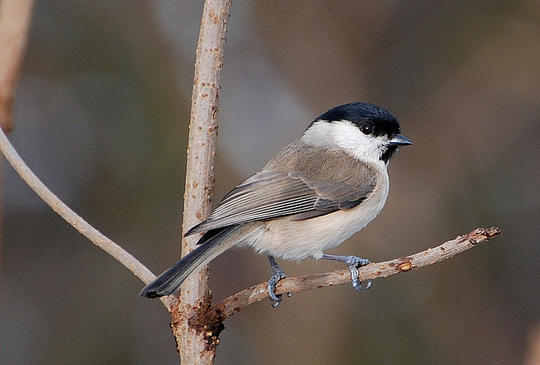
Community woodland management: Urmston Meadows
The Urmston Meadows Action Group was created by Red Rose Forest with support from Trafford Council as part of the Trafford Countryside Management Partnership, to get local communities involved with and invested in the Urmston Meadows site in Trafford, Greater Manchester.
This dedicated group of residents not only regularly make great use of their local Urmston Meadows green space, but are keen and willing to venture out on Saturdays with help from The Conservation Volunteers, to get their hands dirty, learn new skills and take some responsibility for making sure this lovely piece of local countryside is kept in tip-top condition for wildlife, residents and visitors.
One of the main priorities of the group initially was to improve the area for the endangered Willow Tit, a red listed species of conservation concern and a UK Biodiversity Action Plan Priority species.
The British Willow Tit population declined by 87% between 1970 and 2005, making it one of the UK’s most rapidly declining breeding birds.
The British Willow Tit population declined by 87% between 1970 and 2005, making it one of the UK’s most rapidly declining breeding birds.
In many parts of England, the Willow Tit has almost disappeared completely. It is thought that this is due to a variety of factors, including competition from other birds, predation and habitat loss.
The Willow Tit has very specific habitat requirements and is the only English Tit species to create a new nest hole each breeding season.
It nests around a metre above ground in standing deadwood and likes scrubby areas where it is able to feed easily.
The Action Group set out to:
- Maintain the existing breeding population of Willow Tit through management and protection of current sites
- Increase both population size and range of Willow Tit through habitat management at new sites

With the help of Lancashire Wildlife Trust’s Mark Champion, a local Willow Tit expert, a range of scrub species have been planted in the area (Elder, Alder, Hazel and Hawthorn) to create new zones of habitat for the birds.
Felled trees have also been cut leaving 1m tall stumps. Once these are well-rotted, they can be used by the Willow Tit for nesting.
Where stumps are unavailable, well-rotted logs have been secured against living trees at a specific height and orientation for the Tits to burrow into, thus providing further nesting sites.
There will also be a programme of surveying and long tem monitoring of the area to complement this great work.
The group also encouraged the establishment of undergrowth, a perfect site for nesting Willow Tits where they can feed on insects and berries.
It is hoped that these actions will help to significantly increase the numbers of Willow Tit in the area.
It is hoped that these actions will help to significantly increase the numbers of Willow Tit in the area. Together with Red Rose Forest, the Urmston Meadows Action Group has achieved a number of other feats over the past year including the thinning of woodland areas, cutting back vegetation overhanging on paths and planting woodland wildflowers.
They have also engaged in practical habitat conservation by clearing vegetation from around the pond area on site to allow more light to reach the water.
It is hoped that this will help with the biodiversity of pond life at Urmston, and there will be a pond dipping activity using Opal Water Survey resources at some point in the future to see if a significant difference has been made.
Urmston Meadows was also the site for a number of other activities, including various surveying tasks and walks, which provided excellent opportunities for locals to improve their biological and environmental knowledge.
Online advertising of these events, posters and regular action group meetings have been very successful in helping to increase volunteer numbers and have clearly demonstrated that people are interested in looking after and improving their local green spaces.
"My work with the action group has given me brilliant experience and insight into planning and running volunteer events," said Emily Corner, Natural Networks Trainee at Red Rose Forest.
"I have gotten to know both the group and Urmston Meadows really well, and feel as though I am making a big impact in improving the site for wildlife and engaging the local community."
"I have gotten to know both the group and Urmston Meadows really well, and feel as though I am making a big impact in improving the site for wildlife and engaging the local community."
If you would like to learn more about Willow Tit numbers in the region, take a look at this document put together by the Greater Manchester Biodiversity Project.
If you fancy getting involved with the Urmston Meadows Action Group or any other volunteering opportunities with Red Rose Forest throughout the Greater Manchester area, please get in touch by emailing Lucy Holland on Lucy@redroseforest.co.uk.
Trees in hard landscapes – Getting it right in Greater Manchester
Contributed by Matthew Millett
Contributor Profile
Grace is a writer and editor here at Platform and also works as a Copywriter at Creative Concern.
She graduated from The University of Nottingham in 2013 with a degree in English and Creative Writing and afterwards interned within the editorial department of a number of publications, before securing a position as Assistant Editor at a Manchester based magazine.




